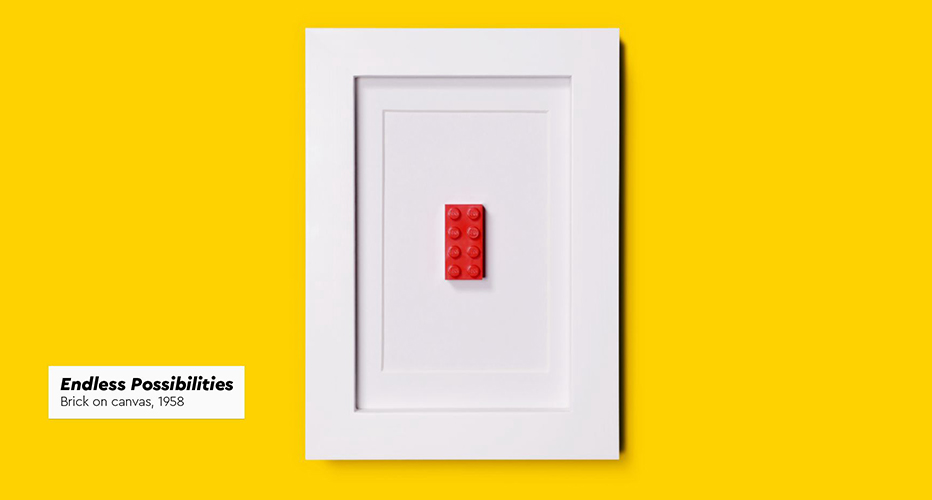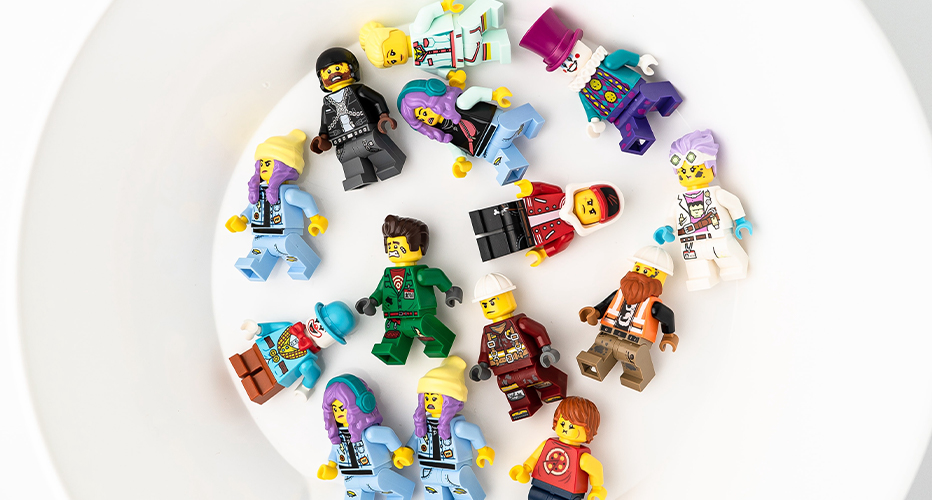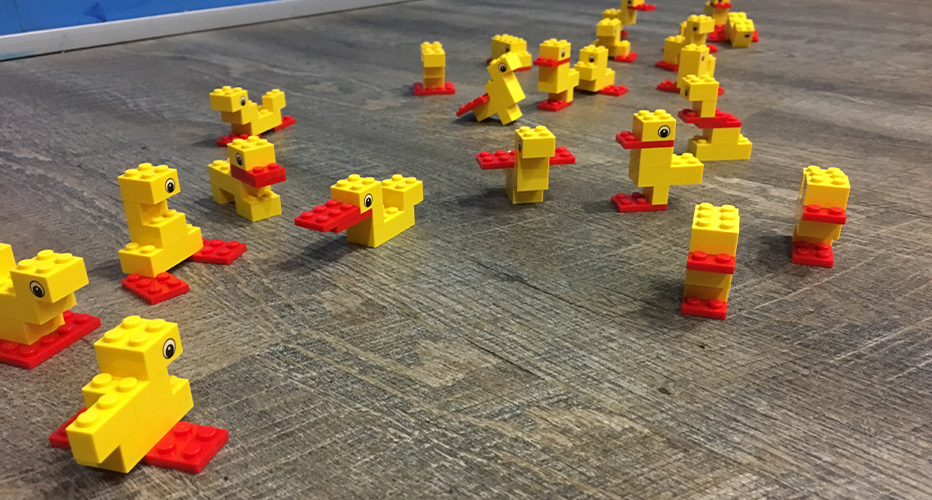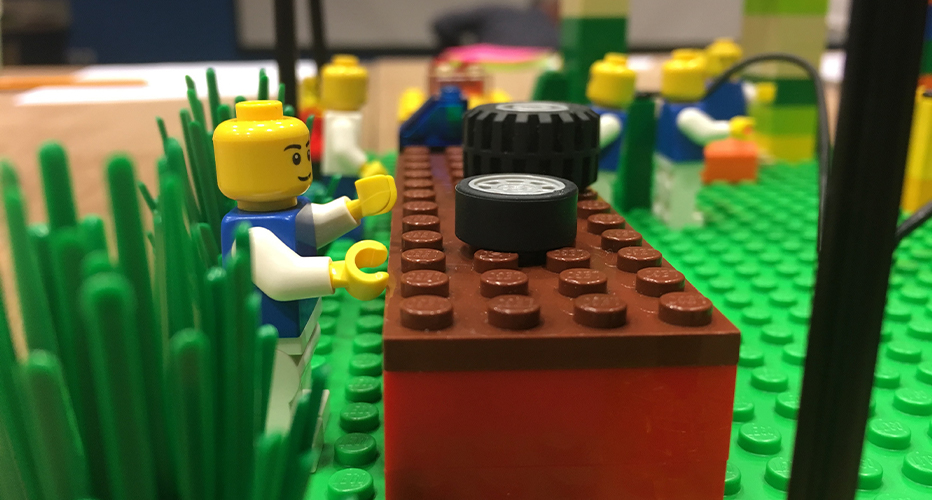FOSTERING CREATIVE THINKING IN THE WAY WE DO BUSINESS
How creating innovation in an active manner drives meaningful change.

2022
So, what have some Legos, a Greek nuts producer, a dizzy octopus & a drunk rooster, a local gas station fighting its own Goliath, and Elon Musk, to do with creativity and Creative Thinking, you may ask. And, frankly, it’s understandable; but give me a few minutes to explain myself.
In a fast-moving world, being able to find new perspectives and actively create innovation is an increasingly valuable skill.
Creative thinkers are more often than not in the vanguard of driving change, solving problems, and developing new ideas. On top of that, those who bring Creative Thinking into how they work are most likely happier, more productive, while also appearing to be more adaptable to whatever comes their way!
Sometimes people ask me “How’s work? Are you happy?” and they often stare at me in disbelief when I reply something like: “I’m feeling very creative (being in a Director position this may sound even odder). I keep finding ways to tackle new challenges creatively, learn something new everyday from my peers, get hands-on on daily projects and in-house challenges and I pretty much feel alive through this process”. Seems unreal, huh?
We are all capable of thinking creatively
Creative Thinking is the ability to approach a problem or challenge from a new perspective, alternative angle or with an atypical mindset.

Which image would you choose to describe your Creative Thinking process?
Creative Thinking is important because it drives new ideas, encourages learning, and creates a safe space for experimentation and risk-taking.
Whatever your background or role, you are capable of thinking creatively and bringing creativity into your life. That’s why, in all the workshops we facilitate, we run a short activity session, for participants to reach and get more comfortable with their creative side and, most importantly, realise we all have one.
Common misconceptions about creativity
Remember that Creative Thinking doesn’t need to be explosive or radical to be useful — a simple shift in mindset or perspective can be all you need to create meaningful and impactful change.
Creativity is not something abstract, contrary to popular belief. It’s not Bob Ross-like “let’s build a happy little idea over here”. It is not about painting, playing music or practice theatre.
Creativity is intelligence having fun. [Albert Einstein]
Creativity is the “ability to produce unexpected original work that is useful and adaptive” [Sternberg and Lubart, 2000] and all psychometric definitions of the term share two common attributes: originality and usefulness. Thus, creativity is not about aesthetics, it does not produce a pleasing in the eyes spectacle or product.
And the other thing that we should agree about is that creativity is not the only skill that will bring ideas; it should be definitely spiced up with empathy, knowledge & expertise, creative-thinking skills & motivation.
-
Back in the University — 20 years ago, but who’s counting, right? — during one of the 1st semester classes, the professor invited us to team up in pairs and find a fresh idea for a Greek nuts producer; a new product that would respond to customer needs and provide profit for the company. So, Fotis & I started brainstorming. It was a rather chilly late-November afternoon in a humid auditorium. We started discussing why people eat nuts and the context in which they interact with the product currently. We thought of people commuting from one place to another, always in a hurry, feeling a bit cold, with low energy levels, wearing their fluffy winterish jackets, putting their hands into their jackets’ pockets to enjoy the much-anticipated warmness.
So, imagine that.. nuts with packaging that fits into a coat’s pocket. Hell, yeah! And we can have mixed nuts, too. Sure, but we need a way for the nuts to remain edible throughout the day, to last longer than a few hours. How about adding a clip, — like the one on the jacket’s pocket — to the nuts’ packaging, perfectly integrated into the existing system (the jacket)! We sketched the clip and its use at a piece of paper, adding funny talking bubbles like “CLIP (the sound of clipping, obviously)” or flirting lines using the inner pocket. Yes, that’s it, but we cannot cancel the primary use of the pocket completely, can we? We should design it so that we (we, as the users) can use the pocket for other reasons as well, e.g. to put actual things in there, duh. Or — you know what — we can create a separate division for the nut shells, also with a clipping mechanism. Brilliant, we are definitely going to be rich someday. We both laughed our heart out and raised our hand to share our idea with our professor.
That evening, without actually realising it, we used a few methodologies and framing techniques that we were later introduced to through the courses or curriculum subjects of Creative Thinking, empathy, inventive thinking, lateral-thinking, visual reading, out-of-the-box thinking, copywriting, artistic creativity, problem-solving, analytical mind, and divergent thinking.
At this point, I will resist the urge to share the story of an octopus in a washing machine and a drunk — but very much alive — rooster, as both stories touch different subjects and lessons learned, such as critical thinking and lean product development approaches.
It’s all about the people, not the ideas
Many people believe that good ideas are rarer and more valuable than good people. Ed Catmull, president of Pixar and Disney Animation Studios, couldn’t disagree more.
If you give a good idea to a mediocre team, they’ll screw it up. But if you give a mediocre idea to a great team, they’ll make it work.
"Toy Story 2 was great and became a critical and commercial success — and it was the defining moment for Pixar. It taught us an important lesson about the primacy of people over ideas: If you give a good idea to a mediocre team, they will screw it up; if you give a mediocre idea to a great team, they will either fix it or throw it away and come up with something that works."
That notion, he says, is rooted in a misguided view of creativity that exaggerates the importance of the initial idea in developing an original product.
In filmmaking and many other kinds of complex product development, creativity involves a large number of people from different disciplines working effectively together to solve a great many inherently unforeseeable problems.

Collective creativity thrives in environments that dismantle barriers between disciplines and actively motivate people to share their work and mind, freely with their peers.
The key to fostering collective creativity within a team or an organisation, as Catmull says, is threefold:
- place the creative authority for product development firmly in the hands of project leaders (as opposed to corporate executives),
- build a culture and processes that encourage people to share their work in progress and support one another as peers and
- dismantle the natural barriers that divide disciplines.
Above all, Pixar trusts smart people over processes and ideas - and I couldn’t agree more.
Solving business problems using Creative Thinking

How many different ducks can we create by starting from the same set of LEGO bricks? The answer might surprise you.
Participating into a Design Thinking with LEGO Serious Play workshop a couple of years ago, I witnessed professionals from different departments & disciplines (Accountants, HR professionals, Engineers, Business Analysts, etc) embracing their Creative Thinking mindset at solving a real business case scenario: a major gas station chain that just opened in the area threatens our local gas station. So, the question was reframed to “how can we remain relevant to our customers and competitive compared to the chain, but also keep being profitable in the long run?”.
Walking through the work tables and listening to what different work groups have to say on how they gave solutions and came up with innovative and contextual ideas for our local gas station, came the realisation that LEGOs were the Trojan Horse of fostering a common language among multi-disciplinary teams, setting the ground for an environment of — as we call it— collective creativity.
Using visual reading, where participants are actually reading ideas and not individual words, was the catalyst for generating collaboratively ideas that were both useful and adaptive.

Visualising your ideas will make an impact to the team by creating a common understanding in order to foster an environment of collective creativity (see Pixar’s example).
What is important here to note is that creativity is actually a function of three components: Expertise, Creative-Thinking skills and Motivation; attributes that all participants had in common that day.
Can we all solve all types of business problems?
Creativity and the Creative Thinking mindset comes in different forms and sometimes you should cultivate and train this mindset towards diametrically opposed directions, when you are called upon to solve a problem. This happens because the problem itself may – or may not in some extremely rare cases - define the type of professional(s) (and their respective skillset) you should choose to solve the problem or challenge.
-
I read recently a quite interesting interpretation of why Elon Musk may not be the right person to solve Twitter’s current challenges.
According to Vincent Turner, most creative people are only good at solving one of the two types of problems that exist in this world: Optimisation problems or Unbounded problems. Here are some definitions, so that the above argument about Elon and Twitter will become clearer:
Optimisation problems
An Optimisation problem is the one most people think of. It’s the type of problem where you ultimately want the measurement that reflects success to trend to either zero (this never happens) or 1 (this happens all the time). Solving these types of problems requires Creative Thinking on how to get the thing being measured to 0 or 1. It might not feel like Creative Thinking, as we’ve been conditioned to think that creativity is only what we observe in the other type of problem, the one I call “Unbounded”.
The examples that Turner gives are indicative of Optimisation problems:
- Safety in airlines (never crash)
- Service in hotels (always deliver)
- Reliability in rocket launches
- Efficiency in a checkout experience
- Consistency of a burrito I ordered
Unbounded problems
An Unbounded problem is where the solution can’t be reached by trying to optimise the existing system. It happens when you reach outside the existing mode of thinking or system entirely. It requires leaps of imagination, iteration in strange or unfamiliar directions, an intuition regarding the human condition and quite often for the zeitgeist to be aligned .. what we often call an idea whose time has come.
So, based on Vincent Turner’s article, Twitter — or the idea of Twitter, is solving an Unbounded problem and the leadership required to solve Unbounded problems is very unlikely to come from the person who is possibly the world leader in Optimisation problems. More specifically:
- Paypal was solving an Optimisation problem
- Telsa is solving an Optimisation problem
- SpaceX is solving an Optimisation problem
- The Boring company seeks to solve an Optimisation problem
- Hyperloop is attempting to solve an Optimisation problem
Optimisation problems are important and Elon is clearly good at solving them (being currently a strong advocate of the “First Principles Thinking”), but the type of thinking required to ‘fix’ Twitter, as Turner believes, is going to come from someone who thinks in an entirely different manner and is given the latitude to solve the problem.
-
Interesting interpretation. Time will tell how this will progress. Let’s harness, though, the fact that problems have indeed their own attributes and each problem — whichever the type we want to classify it into — requires different thinking approach (or plural, approaches), sometimes quite contradictory to one another.
Thus, we — as professionals — should train and educate ourselves towards different mindsets and thinking methods, inspecting and adapting to each problem’s space.
So, touching ground, creativity tends to change the way we do things and the way we view the world, and this is something invaluable in Business world.
Plenty of food for thought, but let’s all agree that Creative Thinking will most definitely give organisations a clear leverage towards any challenge, opportunity or problem that will come our way in the upcoming years.
We have the people, the tools, the right mindset, the expertise, the Technology and the motivation to create double rainbow awesome Products & Services!
-
ATCOM: From Digital to Purpose
Have you heard? ATCOM was named UX/CX Agency of the Year at the UX | CX Awards 2022! Learn all about it here!

